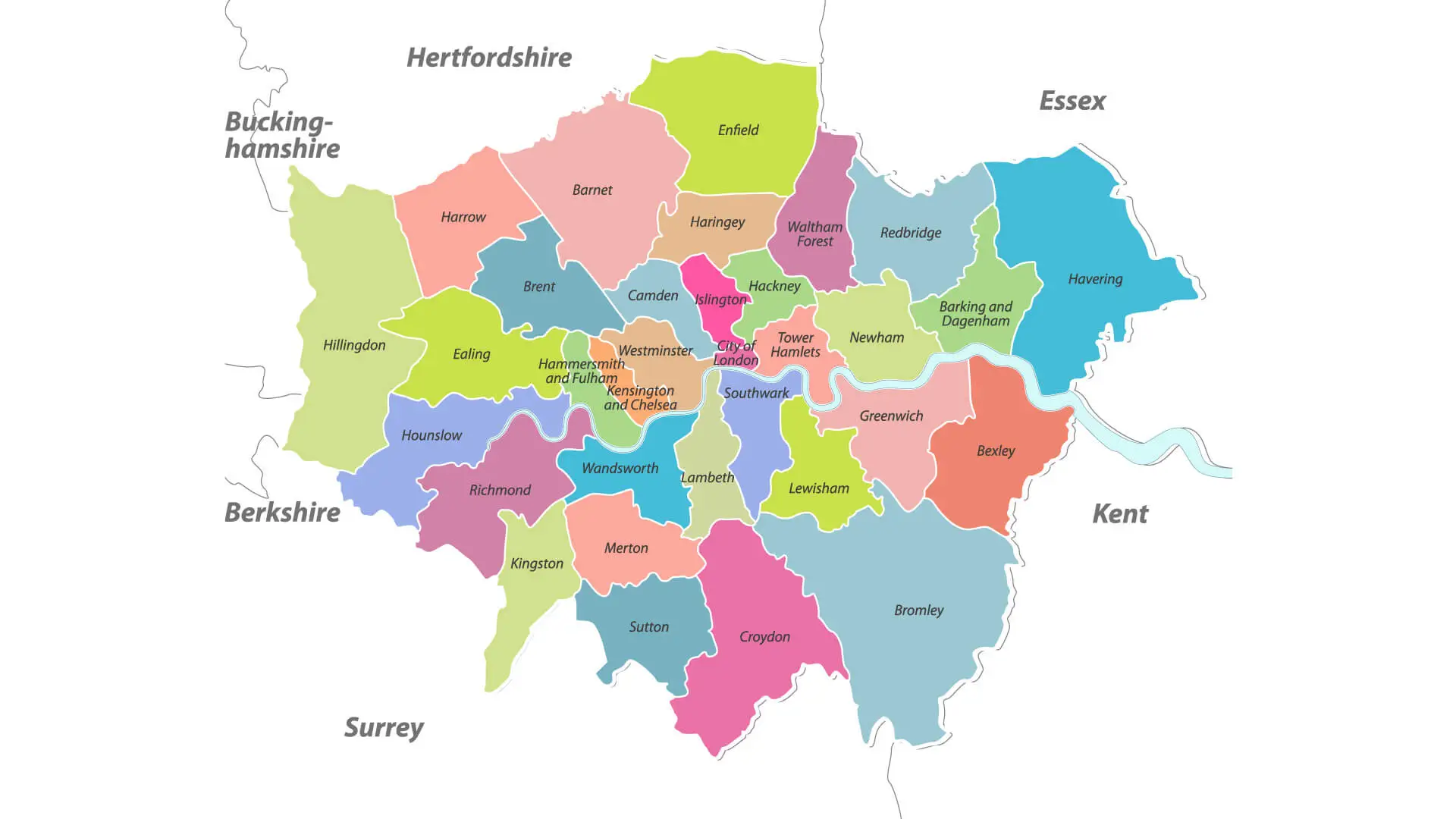London is the financial, educational, historical, and cultural center of the United Kingdom. Being one of the largest cities in the world, it is a well-liked place to live because it provides a wealth of exciting activities and opportunities.
With well-known landmarks and undiscovered treasures around every corner, modern skyscrapers coexist with historic churches.
In 1777, author Samuel Johnson remarked, “A man is tired of life when he is tired of London.”
Almost 250 years later, that sentiment is still valid. With more than 300 languages spoken, London is a vibrant, diverse city with plenty to do and plenty to eat.
Selecting a place to call home is a significant choice. You should be aware of the best neighborhoods in London if you’re considering relocating there. We’re here to help, so don’t worry. The greatest neighborhoods in London are examined in this guide.
Where is London?
London is nestled in the heart of the South East of England on the banks of the River Thames, which dominates the city. A fairly flat city, London is easy to get around on foot, by bike or on the world-famous Underground. What’s more, it’s one of the greenest cities in the world, with nearly 50% of the total area consisting of parks and other natural habitats.
London, the capital of the United Kingdom and one of the biggest cities in Europe, is a major hub for technology, finance, and culture worldwide. It has first-rate transportation connections to the rest of the UK, Europe, and the world, as one might anticipate.
Every city in the UK, as well as Paris, Brussels, Rotterdam, Amsterdam, and other major European cities, can be reached by rail with ease using the Channel Tunnel and Eurostar trains. London’s four main airports—Heathrow, Gatwick, Luton, and Stansted—as well as two smaller ones—London City and Southend—all provide direct flights to important locations worldwide.
Attractions & Amenities
From famous landmarks to top-notch cultural institutions, London has an unmatched selection of attractions. Numerous its galleries, museums, and historical sites are well-known throughout the world and would be a must-see for anyone:
- Historic Landmarks & Monuments: London’s skyline is defined by well-known landmarks. Among the city’s iconic landmarks that attract millions of tourists are Big Ben (Elizabeth Tower at the Palace of Westminster), Buckingham Palace, Tower of London, Tower Bridge, St. Paul’s Cathedral, and the London Eye. London’s rich history is reflected in its four UNESCO World Heritage Sites: Westminster Palace/Abbey, Maritime Greenwich, Kew Gardens, and the Tower of London. London is instantly recognizable around the world thanks to these iconic buildings, which range from Victorian wonders to medieval castles.
- Museums & Galleries: Many of London’s cultural collections are free to enter, making them some of the best in the world. Highlights include the Victoria & Albert Museum, Natural History Museum, Science Museum, Tate Modern (contemporary art in a former power station), the British Museum (which houses the Rosetta Stone and Parthenon Marbles), and the National Gallery (which features masterpieces like Van Gogh’s Sunflowers). These organizations provide engaging exhibits for all interests and cover a wide range of subjects, including science, art, and history. Notably, London’s museum landscape is further expanded by recent additions like the V&A East in 2025.
- Theatres & Music Venues: Often compared to Broadway, London’s West End is a renowned theater district. You can see everything from cutting-edge plays to popular musicals at the more than 40 theaters in the West End alone. While modern concerts fill arenas and famous locations (like Hammersmith Apollo), classical music and opera flourish at places like the Royal Albert Hall and Royal Opera House. Every night of the week, London’s live music scene is lively, featuring everything from jazz clubs to rock concerts.
- Parks & Green Spaces: London is surprisingly green for such a densely populated city. There is a lot of greenery, lakes, and even wild deer (in Richmond) in large parks like Hyde Park, Kensington Gardens, Regent’s Park, Greenwich Park, and Richmond Park. There are beautiful walking and cycling routes along the Thames Path and newly developed parklets (such as those along the Thames Tideway project). Popular places to get some fresh air are Hampstead Heath (which offers sweeping city views from Parliament Hill) and Kew Gardens (botanical gardens). From summer concerts to winter ice skating, these parks host outdoor activities.
- Markets and Shopping: From luxury to vintage, London is a shopping haven. One of the busiest shopping areas in Europe is Oxford Street and Regent Street, which are dotted with flagship stores. While bargain-hunters like markets like Camden Market (alternative fashion and crafts), Portobello Road (antiques), Covent Garden (artisans and street performers), and Borough Market (gourmet food), high-end shoppers often visit Harrods and Bond Street boutiques. New locations like the IKEA Oxford Street flagship store, which will open in 2025 and feature six floors of home goods, a food hall, and even a Swedish deli, will boost retail therapy..
- Entertainment & Recreation: In addition to theaters and museums, London has a wealth of recreational opportunities. In addition to riverfront dining with views, the South Bank area is home to attractions like the National Theatre, SEA LIFE Aquarium, and the London Eye. Families swarm to Warner Bros. Studio Tour (just outside of London) or the London Zoo (Regent’s Park) to experience Harry Potter. See below for London’s nightlife; there’s always something going on thanks to the city’s pubs, clubs, and events.
All of these facilities combine to make London a city where you can dine on international cuisine in the evening, explore centuries of history in the morning, and see a popular show in the afternoon. “The capital has everything you could want from a metropolis, from excellent restaurants and peerless pubs to fascinating museums and one-of-a-kind attractions,” as Time Out London aptly puts it. Like many others, you could spend a lifetime exploring London’s treasures!
Transportation
London’s transportation network is extensive and well-integrated, allowing millions of residents and visitors to move around the city each day without a car. Key components of London’s transport in 2025 include:
- Public Transit – “TfL” System: Transport for London (TfL) runs a vast public transit system known for its coverage and frequency. The London Underground (Tube), the world’s oldest metro (since 1863), remains the backbone: it has 11 lines, 272 stations, and about 5 million passenger journeys daily at peak usage. New upgrades like the Elizabeth Line (opened 2022) have expanded east–west capacity, cutting journey times across the city. In addition to the Tube, the Docklands Light Railway (DLR) serves East London and the Docklands with driverless trains, and the London Overground network connects peripheral districts. A south London tram line operates in Croydon/Wimbledon. Virtually all parts of Greater London are accessible by rail or Tube, with service from early morning until around midnight (and 24-hour Night Tube service on some lines over weekends).
- Buses: London’s red double-decker buses are iconic and essential to the transport network. TfL manages ~9,300 buses on 675 routes, knitting together areas between rail stations. Buses operate extensive hours (many 24/7 or night routes) and are integrated with the same fare system (Oyster/contactless payments). They provide an affordable way to sightsee as well – a ride on the top deck past Big Ben or across Tower Bridge is a London experience itself. There are also limited tram services in south London and river bus services on the Thames for alternative commuting.
- Cycling & Walking: London has invested heavily in cycling infrastructure. Dozens of protected Cycleways (formerly Cycle Superhighways and Quietways) crisscross the city, making cycling safer and more popular. The Santander Cycles bike-share program offers 12,000+ bicycles at over 800 docking stations around central London, available 24/7 for short rentals. Cycle hire costs just ~£1.65 per 30 minutes, encouraging both commuters and tourists to bike. Many Londoners also walk as part of daily travel – the city’s goal is for 80% of trips to be by walking, cycling or public transport by 2041 . Pedestrian-friendly initiatives (e.g. car-free squares, riverfront promenades) continue to expand in 2025.
- Roads & Driving: Driving in central London is discouraged by design – congestion is high and parking scarce/expensive. The Congestion Charge Zone (and expanded Ultra Low Emission Zone) impose fees on most vehicles entering central areas, pushing commuters toward transit. Still, London has an extensive road network for those who do drive: major radial routes and the M25 orbital motorway encircle the metro. Taxis are plentiful – London’s black cabs are famous (with knowledgeable cabbies who pass the rigorous “Knowledge” exam of 25,000 streets), and ride-hailing apps (Uber, Bolt, etc.) also operate. In summary, cars are not needed for most Londoners, but roads link the city efficiently to the rest of the UK.
- Air Travel & International Links: London is a major global travel hub served by six international airports. The busiest is Heathrow Airport, which handled 83.9 million passengers in 2024. Heathrow is one of the world’s busiest airports, offering flights to 200+ destinations.
Housing Market
London’s housing market in 2025 remains one of the most expensive in the world. Both purchase prices and rents are high, with strong demand outstripping supply in many areas. Here are key points about the property market:
- Property Prices: London has the highest average house prices in the UK. As of late 2024, the average home price in London is around £549,000 (vs ~£291k England average). This average was essentially flat in 2024 (0% annual change), after years of growth, as rising interest rates tempered the market. Prices vary hugely by location: affluent central boroughs are far above average. For example, Kensington & Chelsea has London’s highest prices, averaging £1.07 million per property. In contrast, outer boroughs like Barking & Dagenham or Bexley average closer to £350k–£400k. Nonetheless, even the lowest-cost boroughs are well above the national average. Buying a home in London often requires a very large deposit and income; it’s common for young Londoners to rent or for buyers to compromise on location/space to get on the property ladder.
- Rental Trends: London’s rental market is very costly and competitive in 2025. The average rent in London reached £2,206 per month by late 2024 – the highest in the UK (more than double the national average). Rents have surged ~12% in a year due to high demand and limited supply, a record growth rate. In practical terms, a one-bedroom flat in a central Zone 1-2 area typically costs anywhere from ~£1,500 to £2,500+ per month depending on neighbourhood and quality. Larger family homes in desirable areas often rent for £3,000–£5,000+ monthly. Renters face intense competition; it’s not uncommon for open houses to attract dozens of applicants. Rental contracts usually require substantial upfront costs (security deposit of 5 weeks rent and one month paid in advance).
- Popular Neighborhoods: London is a city of diverse neighbourhoods, each with its own character and housing costs. Some trends in 2025:
- Young Professionals gravitate toward vibrant areas with good transport and nightlife. Examples include Shoreditch and Hackney (trendy East London enclaves for creatives/tech workers), Clapham and Brixton (social hubs in South London), and Islington or Camden (lively areas in North London). These districts offer apartments (often shared) with easy commutes and plenty of bars, cafes, and culture on the doorstep.
- Families often seek more space, green areas, and schools. Leafy outer boroughs are popular, such as Richmond upon Thames (southwest, known for its parks and top safety ratings), Greenwich (southeast, with parks and good schools), Wimbledon or Kingston (family-friendly feel), and parts of North London like Barnet or Sutton. These areas offer larger houses or spacious flats, gardens, and a suburban vibe while still in Greater London.
- Luxury/Wealthy Areas remain around prime central London: Mayfair, Knightsbridge, Kensington & Chelsea, Belgravia, South Kensington, etc. These neighbourhoods feature multi-million-pound properties, from white-stucco townhouses to modern penthouses. They attract affluent international buyers and professionals in finance or entertainment. Services and shopping in these areas are upscale (think Harrods in Knightsbridge).
- Students cluster near universities or in affordable pockets with good transit. Bloomsbury (central, near UCL and University of London colleges) has many student halls and flats. New Cross and Greenwich serve Goldsmiths and the University of Greenwich; South Kensington serves Imperial College. Areas like Stratford (East) or Elephant & Castle (South Central) have seen student accommodation development too. London’s student population of over 400,000 ensures a constant demand for flat-shares and dorms.
In summary, living in London requires a hefty housing budget. Many residents make trade-offs – such as renting farther out and commuting – to manage costs. Yet despite the expense, people continue to flock to London for the opportunities and lifestyle (see “Ideal For” below), keeping the housing market very active.
“Ideal For” – Who Finds London Appealing?
London’s dynamic environment appeals to a broad range of people, particularly those seeking opportunity, culture, and diversity. While some thrive in its fast-paced atmosphere, others may find challenges in affordability and space.
- Young Professionals & Career Starters: London attracts ambitious graduates and professionals in industries like finance, tech, media, and the arts. With 23.5% of Inner London’s population aged 25–34, it offers unmatched career opportunities, vibrant nightlife, and social networks. Many live in shared flats or city-center apartments before relocating in their 30s for more space.
- Students: Home to over 400,000 university students, London’s world-class institutions (UCL, Imperial, LSE, King’s College) and diverse culture make it a top choice for higher education. Students benefit from discounted transport, internship opportunities, and a dynamic social scene.
- Families: London provides top schools, museums, parks, and family-friendly attractions, particularly in suburban areas like Richmond, Sutton, and Bromley. However, high housing and childcare costs push some families to relocate. Those who stay enjoy a diverse, enriching urban upbringing for their children.
- Retirees: Only 12–14% of London’s population is 65+, lower than the UK average. While many leave for a quieter life, affluent retirees appreciate London’s healthcare, cultural life, and transport convenience. Areas like Hampstead and Richmond cater well to active seniors.
- Immigrants & Expats: London remains one of the world’s most cosmopolitan cities, with 41% of residents born abroad and over 300 languages spoken. Large diaspora communities make integration easier, and career opportunities continue to attract global talent.
Overall, London suits those who thrive on urban energy, career growth, and cultural diversity. Young professionals and students find it most rewarding, while families and retirees often weigh affordability and lifestyle factors before settling.
Crime Rates
London, like any major city, has areas of varying safety. While crime has risen slightly post-pandemic, the city remains moderately safe compared to global standards.
- Overall Crime Rate: 105–106 offenses per 1,000 people per year (2023/24), with around 850,000 reported crimes in Greater London. This is higher than smaller UK towns but similar to other major cities.
- Common Crimes: The most reported offenses include violent/sexual crimes (22% of all incidents, ~29 per 1,000 people) and theft-related crimes (pickpocketing, burglary, shoplifting). Knife crime is a concern in some inner-city areas, while gun crime remains low due to strict UK laws.
- Safest Areas: Richmond upon Thames, Kingston upon Thames, and Harrow report the lowest crime levels, particularly for violent crime and burglary.
- High-Crime Areas: Westminster, Hackney, and Tower Hamlets have some of the highest crime rates, largely due to high foot traffic, nightlife, and some gang-related incidents. Parts of Croydon and Lambeth also report above-average crime in certain wards.
- Crime Trends & Safety Measures: Crime is higher at night, especially in nightlife areas like West End, Shoreditch, and Brixton. The city has increased police patrols, expanded CCTV coverage, and implemented anti-violence initiatives. Terrorism remains a potential risk (threat level: “substantial”), but no major attacks have occurred in recent years.
- Personal Safety: Most Londoners feel safe in their daily routines. Petty theft is the biggest risk in tourist hotspots, so precautions like staying aware, avoiding flashy valuables, and using licensed transport at night are recommended.
Overall, London’s crime rate is higher than rural areas but not extreme for a major metropolis. Millions navigate the city safely every day, with common-sense precautions helping mitigate risks.
Cost of Living
London remains one of the most expensive cities in the world, with high costs across housing, transport, food, and entertainment. While salaries are higher to compensate, budgeting is essential.
- Housing: The biggest expense, with average rents at £2,200/month and home prices around £549,000. Many Londoners spend 40–50% of income on housing and often share accommodation to cut costs. Council Tax adds £100–£300/month depending on the area.
- Utilities & Bills: Monthly electricity, gas, water, and internet cost £150–£200 for a small flat. Council Tax and service charges can push total household bills to £300–£400/month.
- Transport: A Zone 1–2 Travelcard costs ~£164/month, with costs rising for longer commutes. Buses are cheaper at £1.75 per ride, while taxis and fuel are expensive (£1.50–£1.70 per liter). Many cycle or walk to save.
- Groceries & Food: A single person spends £250–£300/month on groceries. Dining out varies: takeaway lunch £5–£8, pub pint £5–£6, casual meal £15, mid-range dinner for two £60–£100. Food markets and ethnic grocers offer budget-friendly options.
- Entertainment & Leisure: Costs vary widely.
- Movie ticket ~£15
- Theatre show £25–£100+
- Gym membership £40–£70/month
- Football tickets £30–£80
- Club entry £10–£20, cocktails £10+
- Childcare: £1,200+ per month per child, making it a major expense for families.
- Overall Affordability: London is 15–20% pricier than other UK cities, with housing nearly twice the national average. A single person needs £1,040/month (excluding rent), and a family of four around £3,670/month. Despite the high costs, free attractions like museums, parks, and cultural events help balance expenses.
London is expensive but offers unmatched career opportunities, lifestyle, and global connections. Careful budgeting makes it manageable, and most find the experience worth it despite the high price tag.
Job Opportunities
London remains the UK’s economic powerhouse, offering diverse job opportunities across multiple industries. With strong salaries and a dynamic job market, the city continues to attract professionals globally.
- Finance & Banking: London’s financial sector contributes £208 billion to the economy, with global banks (HSBC, Barclays, JPMorgan) and fintech startups driving growth. High-paying roles in investment banking, compliance, and sustainable finance remain in demand.
- Technology & Digital Industries: Often called “Europe’s tech capital”, London houses major tech firms (Google, Meta, Amazon) alongside a booming startup ecosystem in fintech, AI, and cybersecurity. Demand for software engineers, data scientists, and product managers remains high.
- Media, Creative & Tourism: London is a global media, fashion, and arts hub, home to BBC, The Guardian, West End theatres, and top film studios. Tourism is recovering post-pandemic, supporting jobs in hospitality, entertainment, and retail (20M+ visitors spent £16.7B in 2023).
- Professional Services & Corporate HQs: Over half of the UK’s FTSE 100 companies are headquartered in London, including BP, Unilever, and GSK. Major employers include law firms, consultancies (PwC, Deloitte, EY, KPMG), and marketing agencies.
- Public Sector, Education & Healthcare: London is a government and healthcare hub, employing thousands in policy, research, and medicine. Leading hospitals (Guy’s & St Thomas’) and universities (Imperial, UCL) provide steady employment.
- Employment Trends 2025:
- Unemployment: ~4–5%, close to the UK average.
- Labour shortages: Tech, healthcare, hospitality, and construction.
- Salaries: London’s median salary (£41K) is well above the UK median (£33K).
- Work culture: Hybrid work remains common, though return-to-office policies are increasing.
London offers high competition but exceptional career growth in finance, tech, media, and beyond. While costs are high, the opportunities, salaries, and professional networks make it a top destination for ambitious professionals.
Lifestyle & Entertainment
London offers an exciting and culturally rich lifestyle with endless entertainment options for all interests.
- Nightlife: From historic pubs to superclubs (Fabric, Ministry of Sound), London’s nightlife is world-famous. Popular areas like Soho, Shoreditch, Camden, and Brixton offer bars, live music, and late-night eats. Night Tube and 24-hour buses make getting home easy.
- Dining & Cuisine: London’s food scene is unmatched, offering Michelin-starred dining, street food markets (Borough, Camden, Boxpark), and diverse international cuisine. From Indian in Brick Lane to Chinatown’s dim sum, the city is a foodie’s paradise.
- Arts & Culture: The West End hosts hit musicals and plays, while world-class galleries (Tate Modern, National Gallery) and museums provide endless exhibitions. Music lovers can enjoy classical concerts, arena tours, and underground gigs.
- Festivals & Events: London’s calendar is packed—Notting Hill Carnival (2M+ visitors), Pride, Chinese New Year, Wimbledon, and the London Marathon draw huge crowds. The city also hosts film, food, and music festivals year-round.
- Sports & Recreation: London is home to 7 Premier League teams, Wimbledon tennis, and major cricket, rugby, and NFL events. Locals stay active with cycling, jogging in parks, and Olympic Park facilities.
- Shopping & Fashion: From Oxford Street and Harrods to Camden Market and luxury boutiques, London is a global fashion hub. Shopping districts double as social hubs with pop-ups and seasonal events.
With world-class entertainment, diverse cuisine, and a vibrant social scene, London’s lifestyle is unmatched, making it one of the most dynamic cities to live in or visit.
Living in London: population and lifestyle
A bustling and exciting city, London is truly unique. From fashionistas to financial advisors and artists to architects, millions of people call it home.
How many people live in London?
London is home to nearly 9 million people, while the wider Metropolitan Area has nearly 15 million… that’s nearly 25% of the UK’s population! With such a huge number of people across a vast area, various parts of London can feel completely different from each other. Leafy, family-friendly suburbs surround the city, while trendy neighbourhoods like Shoreditch, Brixton and Camden are found more centrally and boast hipster bars and cafes, trendy street markets and independent shops.
London cost of living
London is an expensive city to live in, with the highest rents and house prices in the UK. In fact, the average rent in London has increased by 32% in the last five years. According to Home Let, the average property in London now rents for £2148 per month. However, there are huge differences between areas, with properties in Kensington & Chelsea averaging £3,459 per month while those in Bexley and Croydon (the cheapest places to live in London) sit at around £1,520.
When it comes to buying and selling a house in London, the average price for a flat sits at around £560,000, while terraced houses are around £800,000, and the average semi sells for £780,000. However, London is also home to some of the most expensive houses in the world, with some selling for hundreds of millions of pounds.
What’s more the cost of food, drink and entertainment is also more expensive in London compared to other UK cities. If you’re looking for somewhere cheaper to live, check out our guide to The 6 Most Affordable Places to Live in the UK.
Where to live in London
There are 32 districts in London, officially known as Boroughs, and choosing the best place to live will depend on your circumstances and budget. If you’re a young professional looking for plenty to do and easy access to central London, areas such as Islington, Peckham, Brixton, Bermondsey Clapham, Camden, Hoxton, Wandsworth and Bethnal Green should be high on your list.
For families and those who prefer a quieter life, with plenty of green space, London has plenty to offer. Consider neighbourhoods such as Blackheath, Fulham, Richmond, Streatham, Twickenham, East Finchley, Hillingdon, Uxbridge, Kingston-Upon-Thames, Sutton, Barnet, Waltham Forest and others.
Although expensive, nothing can beat living in Central London for the true city experience. Whether it’s taking in a West End show, shopping on Regent Street or visiting famous galleries and attractions like the Tate Modern, Natural History Museum, British Museum or the South Bank Centre, it’s all on your doorstep.
Is London a good place to live?
Yes! London is a fantastic city that can truly hold its own against other famous spots like New York, Paris, Tokyo and LA. It offers everything that anybody could want, from world cuisine and culture to high fashion, cutting-edge technology, world-beating education institutions and a history that spans millennia. Although it can be an expensive city, the price is often worth it for the experience alone.
Is London worth visiting?
Yes! London is a city that blends rich history, world-class culture, modern attractions, and a vibrant social scene. Whether you’re fascinated by royal palaces, historic sites, or contemporary art, London offers something for everyone. From iconic landmarks like Big Ben and Buckingham Palace to hidden gems like Camden Market and Hampstead Heath, the city never runs out of exciting experiences.
- Tourism Boom: London welcomed 20+ million international visitors in 2023, a number expected to rise in 2025.
- Top Attractions: Tower of London, Westminster Abbey, British Museum, London Eye, West End theatre.
- Cultural Hotspots: Over 170 museums, including Tate Modern and the Natural History Museum.
- Vibrant Social Scene: Countless pubs, restaurants, and late-night spots catering to every taste.
What’s special about London?
London is one of the most historically and culturally significant cities in the world. It combines royal heritage, cutting-edge business, and a cosmopolitan lifestyle like no other city. Whether you’re strolling through centuries-old streets or enjoying a futuristic skyscraper view, London offers an unparalleled mix of old and new.
- Global Financial Hub: London contributes £500+ billion to the UK economy.
- Cultural Capital: Home to West End theatre, top museums, and music festivals.
- Diverse & Inclusive: Over 300 languages spoken, with 41% of residents foreign-born.
- Historic Landmarks: Big Ben, Tower Bridge, St. Paul’s Cathedral, Buckingham Palace.
Why do tourists go to London?
London is a bucket-list destination known for its historic sites, vibrant arts scene, and world-class entertainment. Tourists flock here to experience a city that has shaped global history and continues to lead in innovation.
- Historic Landmarks: Tower of London, Westminster Abbey, Buckingham Palace.
- Arts & Theatre: The West End sells over 15 million theatre tickets annually.
- Green Spaces: 3,000+ parks, including Hyde Park and Regent’s Park.
- Shopping & Dining: Oxford Street has over 300 stores, and London boasts 60+ Michelin-starred restaurants.
Why do people move to London?
London attracts people from all over the world due to its strong job market, high salaries, education opportunities, and diverse culture. Whether you’re a young professional, entrepreneur, student, or expat, London offers unmatched career and lifestyle opportunities.
- Jobs & Economy: Over 6 million jobs across multiple industries.
- Higher Salaries: Median salary of £41,000 (UK average: £33,000).
- World-Class Education: 400,000+ students enrolled in 40+ universities.
- Global Networking: Work alongside top professionals in finance, tech, media, and research.
Is London cheap or expensive?
London is one of the world’s most expensive cities, but high salaries and free attractions help balance costs. While housing and dining can be pricey, smart budgeting and discounts make city life manageable.
- Housing Costs: £2,200/month average rent; £549,000 average home price.
- Transport: £164/month for a Zone 1–2 Travelcard; £1.75 per bus ride.
- Food & Dining: Groceries cost £250–£300/month per person; a casual restaurant meal is £15–£20.
- Entertainment: West End shows (£25+), football matches (£30–£80), museums (mostly free).
What are the advantages of living in London?
Living in London means access to world-class opportunities, entertainment, and diversity. Whether you want a thriving career, a lively social life, or cultural experiences, London offers it all.
- Career Growth: Jobs in finance, tech, healthcare, and creative industries.
- Global Connectivity: 6 airports, with flights to 300+ destinations worldwide.
- Cultural Diversity: Over 9 million people from 300+ nationalities call London home.
- Vibrant Social Life: 3,500+ pubs, 60 Michelin-starred restaurants, 200+ theatres.
- Public Transport: Extensive Tube, bus, cycling, and 24-hour transport options.
- Green Spaces: Over 3,000 parks, 8 royal parks, and walking trails along the Thames.
Is it worth staying in London?
For many, London’s career prospects, lifestyle, and cultural richness outweigh the high costs. While some leave for affordability, others stay for unmatched networking, education, and personal growth.
- Business & Startups: London is a top hub for startups and multinationals.
- Education & Research: A global center for top universities and innovation.
- World-Class Healthcare: Leading NHS hospitals like Guy’s & St Thomas’ and Great Ormond Street.
- Entertainment & Social Life: Always new restaurants, nightlife, and festivals to explore.
What is London famous for?
London is known for its royal heritage, cultural institutions, finance industry, and football clubs. It remains a global leader in arts, fashion, business, and politics.
- Historic Landmarks: Big Ben, Buckingham Palace, Tower of London, Westminster Abbey.
- Cultural Powerhouse: British Museum, National Gallery, Tate Modern, West End theatre.
- Financial Center: Contributes over £500 billion to the UK economy.
- Premier League Football: 7 clubs, including Arsenal, Chelsea, and Tottenham.
What is the crime rate in London?
London’s crime rate in 2025 is ~105–106 offenses per 1,000 people, making it higher than rural areas but typical for a global city. While petty theft and fraud are the most common crimes, violent crime is concentrated in certain areas.
- Crime Hotspots: Westminster, Hackney, Tower Hamlets (due to nightlife and tourism).
- Safest Areas: Richmond, Kingston upon Thames, Harrow.
- Common Crimes: Theft, fraud, and assault, with police focusing on knife crime reduction.
- Security Measures: London has CCTV surveillance, strong police presence, and counter-terrorism initiatives to ensure safety.
Upcoming Projects for London
By 2025 London, the capital of the United Kingdom, is still a vibrant worldwide city. Driven by decades of expansion, the population of Greater London is almost 9 million (ONS mid-2023 estimate of 8.95 million), a historic high. Driven mostly by service sectors including finance, technology, and professional services, the city accounts for roughly 22–25% of the GDP for the United Kingdom London takes pride in its economy’s recovery from the epidemic, which has led to a modest increase in the UK GDP by 0.9% in 2024.
Surrey and London have a special relationship that combines suburban peace with urban convenience. Their close proximity lets them complement each other, which makes Surrey a desirable place for people who live in London but would rather have a more sedate, roomy living space.
Reflecting ongoing infrastructure and cultural investment, major development projects will be changing London in 2025. Notable initiatives almost finished this year include:
- Opening in April 2025 to alleviate traffic, the first new Thames road tunnel in thirty years is Silvertown Tunnel (Newham).
- Opening May 2025, V&A East Museum (Stratford) is a new 4-story branch of the Victoria & Albert Museum displaying varied collections ranging from vintage football jerseys to Elton John’s outfits.
- A £1.3 billion makeover of the Olympia exhibition centre into a cultural hub with two new hotels, a 1,575-seat theatre, a 4,000-capacity music arena, and 30+ restaurants, Olympia Redevelopment
- Comprising 7 new riverside “mini-parks” along its path, Thames Tideway “Super Sewer” is a massive new sewer tunnel under the Thames (fully operational in 2025) meant to clean the river.
London remains one of the safest major cities, though taking precautions in busy areas is advised. Millions live, work, and travel here safely every day.
If you’re looking to sell your London home, don’t hesitate to contact us. We will make you a free cash offer within 7 days. Perhaps you’re looking to move to the suburbs to start a family? Or maybe you’ve inherited a property in the capital? We bypass expensive estate agent fees and drawn-out processes to keep things simple.





